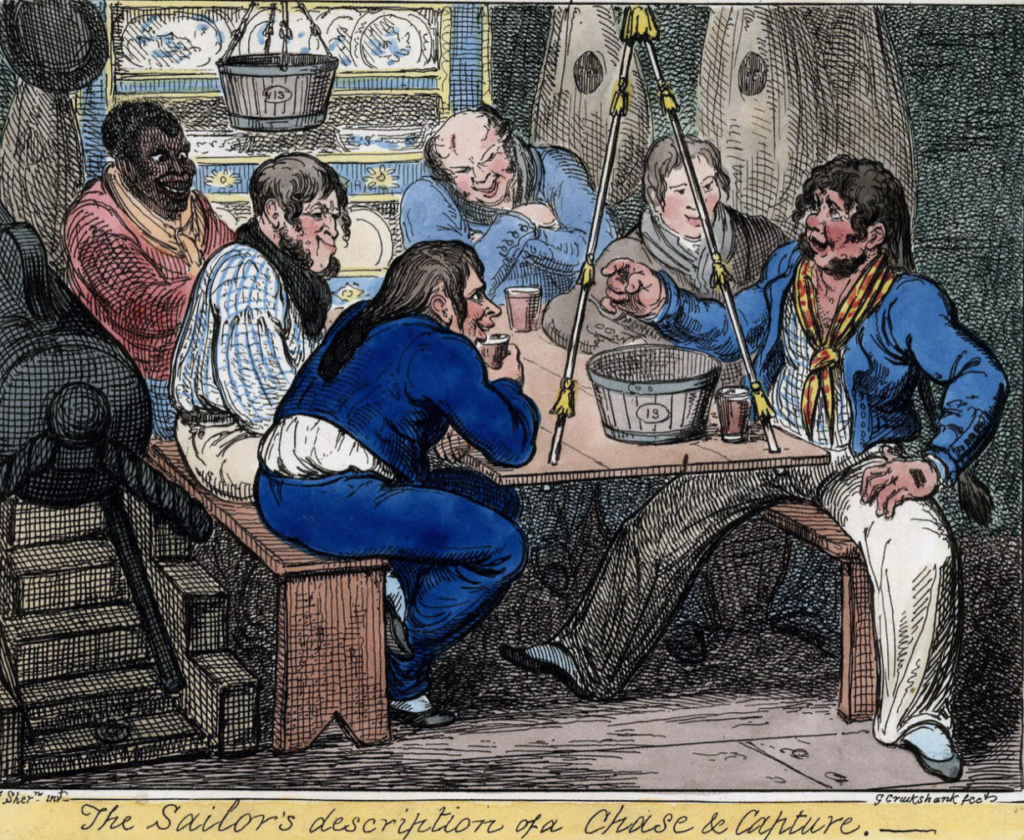Chanteys, Chanties, Shanties: although it’s generally been pronounced with a sh, the spelling was never standardized, and neither was the music. Sung on sailing ships the world over in the 1800s, chanteys are often thought of as Anglo-American, but in fact no greater variety of influences can be found anywhere. Ships do call at ports, after all.

On the English and American ships there was a prevalence of converted work songs from Ireland, Scotland, England and America. Sailors found a song in every port, and picked up lots of Black folks’ songs and styles, especially in the American South and the Caribbean. Black stevedores worked many of the ports, and Black sailors enlisted on the same ships. (Often these ships were not so integrated as that might imply: “chequerboard crews,” which consisted of separate White and Black watches, were common.) One authority tells us, with quaint prejudice,
The southern negroes are not gifted to sing a chorus in union and consequently they employed their harmonious faculties on the chantey, with the result that the whites soon began to imitate them, picking up heavier choruses until the chanties reached their zenith in the 1870s.[i]
A more laudatory view is taken by Stan Hugill, whose extensive 1961 study Shanties From the Seven Seas mentions songs of Black origin and Black stylistic influence hundreds of times. Hugill, a sailor and “shantyman” himself, is rare among writers on this subject in crediting large numbers of songs to African-Americans, including “Blow the Man Down,”[ii] “Roll the Cotton Down,” and “Shenandoah.”[iii
After all, African-Americans didn’t only pick cotton—they loaded it on ships. They brought their cotton-pickin’ songs down to the port, where they became cotton-packin’ songs. Many songs from the plantation made their way around the world before they burst back onto the American scene and transformed American music. We noted earlier a relationship between corn-shucking songs and the high seas. Consider:
Seven years a-boiling
Ho-ma-hala-way
Seven years a-baking
Ho-ma-hala-way
The blowed the horn for dinner
Ho-ma-hala-way
The people could not eat her
Ho-ma-hala-way[iv]
Roger Abrahams notes a similarity here to the common haul away refrain of many chanteys, explaining that work songs are highly adaptable and can travel from plantation to convict labor camp to the seven seas. And not only do the songs travel, but their uses as well: these songs are not just a way to while away idle hours but also a way to continue the conversation about important matters. They often carry coded messages, with the wild goose in both examples representing something more important—a captive laborer resisting her/his status, perhaps. Thus a living tradition rolls on through the call and response between shucker and sailor, captive and convict, downtrodden workers all. We will see this tradition reiterated in the blues, and everything that follows.
Other types of work songs went to sea too, especially railroad-building songs. Yet another song source was the minstrel show, which muddied the waters with stereotyped White imitations picked up in port by White sailors.
Many of the songs brought to the waves by Blacks were reworked English folksongs. Many others were Irish or of some other European origin, with the result that American, British and Irish sailors ended up singing European songs in African-American fashion.
Blacks from the West Indies or the U.S. South worked the high seas in great numbers, as did the Irish, and these two groups together accounted for a large percentage of the songs of the sea. I use the word “together” advisedly, for the cooperative work led to cooperative songmaking, chequerboard watches notwithstanding. These two groups were also responsible for much of the railroad track laid through America beginning in the 1880s. Hugill cites many songs as being “probably a Negro-Irish mixture,” indicating that sometimes “the tune came from Ireland to Mobile, where the Negroes took it in hand and then at a later date it returned to sea with a few more alterations.”[v]
And aside from the songs themselves, Blacks introduced a style of singing so exceptional that most of the White sailors never got it, and wouldn’t even attempt certain songs unless a Black singer was on board to lead the tune. In Hugill’s account,
One of the reasons why Negro shantymen were so good at their job was because of their ability to handle these wild falsetto “yodels” (hardly the correct term though!) much better than white men. Sailors called these yells “hitches” and they were performed either by a break or several breaks in the voice on a certain note, or else by emitting a high yelp at the end of a solo line.[vi]
He goes on to tell of a West Indian sailor known as “Harding, the Barbadian Barbarian,” who “would give vent to many wild ‘hitches,’ absolutely impossible for a white man to copy, although white sailors did execute a poor shadow of these Negro yelps.”[vii] The other significant difference in style was that Blacks normally, after the first couple of verses, improvised lyrics from their storehouse of stock characters, situations, and expressions. Whites tended to recount a song’s tale intact, reproducing the tradition as noted earlier.
[i] Harlow 1962, 7.
[ii] Hugill 1961, 10.
[iii] ibid., 140.
[iv] Abrahams, 190.
[v] Hugill 1961., 258.
[vi] ibid., 29.
[vii] ibid., 71.
